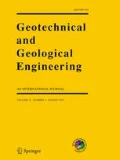Abstract
The Saga Plain in Japan contains a 10–30 m thick Holocene clayey soil deposit with a natural water content generally more than 100% and a liquidity index (I L ) larger than 1.0. Most of this is a marine deposit known as the Ariake clay formation. Using salinity in the pore water of this deposit as an index, the mechanism of post-depositional salinity leaching from the Ariake clay formation has been investigated. This has been achieved using current measurements of the salinity distribution in the deposit and the groundwater flow velocity in an underlying Pleistocene gravelly sand layer, together with advection–diffusion analyses. It is suggested that diffusion together with possible rainfall percolation and/or upward seepage flow from the Pleistocene gravelly sand layer was the main mechanism causing salinity leaching. Detailed analysis of the test results from four boreholes indicates that for the locations where the activity of the clay minerals was less than 1.25, salinity leaching probably accounts for the observed low undrained shear strength (<0.5 kPa) of remoulded soil samples, high values of the sensitivity (S t ), and the formation of a quick clay.















Similar content being viewed by others
References
Bjerrum L (1967) Engineering geology of Norwegian normally consolidated marine clays as related to settlements of buildings. Geotechnique 17:81–118
Bo MW, Arulrajah A, Sukmak P, Horpibulsuk S (2015) Mineralogy and geotechnical properties of Singapore marine clay at Changi. Soils Found 55(3):600–613
Chung CK, Finno RJ (1992) Influence of depositional processes on the geotechnical parameters of Chicago glacial clays. Eng Geol 32(4):225–242
He P, Ohtsubo M, Abe H, Higasgi T, Kanayama M (2014) Quick clay development and cation composition of pore water in marine sediments from the Ariake Bay Area, Japan. Int J Geosci 5:595–606
Hino T, Chai J-C (2014) Lecture No. 5: Evaluating the effect of sea level change on geo-environment, in a lecture series of global warming induced geoenvironmental change and geo-disasters. Jpn Geotech Mag 62(1):53–58
Hino T, Chai J-C, Negami T, Bergado DT and Jia R (2014) Assessment of the effects of sea-level change on the geoenvironment: the case of the Ariake Sea coastal lowlands. In: Proceedings of the 9th international symposium on lowland technology, Saga, Japan, pp 21–30
Horpibulsuk S, Shibuya S, Fuenkajorn K, Katkan W (2007) Assessment of engineering properties of Bangkok clay. Can Geotech J 44(2):173–187
Liu S-Y Liu, Shao G-H, Du Y-J, Cai G-J (2011) Depositional and geotechnical properties of marine clays in Lianyungang, China. Eng Geol 121(1–2):66–74
Miura N, Chai J-C, Hino T, Shimoyama S (1998) Depositional environment and geotechnical properties of Ariake clay. Indian Geotech J 28(2):121–146
Mizota C, Longstaffe FJ (1996) Detrital origin for smectite in soils and sediments from the coastal plain of Ariake Bay, northern Kyushu, Japan. Geoderma 73:125–130
Norsk Geoteknisk Forening (1974) Retningslinjer for representasjon av geoteknisk undersökelser. Oslo, p 16
Ogata A (1970) Theory of dispersivity in a granular medium. US Geological Survey, Professoins Paper
Ohtsubo M, Takayama K, Egashira K (1982) Marine quick clays from Ariake Bay area, Japan. Soils Found 22(4):71–80
Ohtsubo M, Egashira K, Kashima K (1995) Depositional and post-depositional geochemistry, and its correlation with the geotechnical properties of marine clays in Ariake Bay, Japan. Geotechnique 45(3):509–523
Robinson RA, Stokes RH (1959) Electrolyte solutions, 2nd edn. Butterworths Scientific Publ, London
Saga Prefecture (2009) Report on general situation of landsubsidence in 2007. Saga Prefecture, Japan, p 64 (in Japanese)
Shackelford CD, Daniel DE (1991) Diffusion in saturated soil: background. J Geotech Geoenviron Eng ASCE 117(3):467–484
Shimoyama S, Nishida I (1999) Environmental changes during last 10,000 years in North Kyushu, West Japan with special reference to shoreline movements. Rekihaku J 81:249–266
Shimoyama S, Matsumoto N, Yumura H, Takemura K, Iwao Y, Miura N, Tohno I (1994) Quaternary geology of the low-land along the north coast of Ariake Bay, West Japan. Research Reports of Faculty of Science, Kyushu University. Earth Planet Sci 18(2):103–129
Shimoyama S, Matsuura H, Hino T (2010) Geology of Saga, Report on Regional Geology Research, 1/50,000 Geology Maps, Fukuoka (14), No. 71, NI-52-11-9. Center for Geological Survey, National Institute of Advanced Industrial Science and Technology, Tokyo, Japan, p 97 (in Japanese)
Sridharan A, Prakash K (1999) Influence of clay mineralogy and pore-medium chemistry on clay sediment formation. Can Geotech J 36:961–966
Torrance JK (1983) Towards a general model of quick clay development. Sedimentology 30(4):547–555
Torrance JK, Ohtsubo M (1995) Ariake bay quick clays: a comparison with the general model. Soils Found 35(1):11–19
Torrence JK (1970) Discussion. Eng Geol 4:353–358
Torrence JK (1979) Post-depositional changes in the pore-water chemistry of the sensitive marine clays of the Ottawa area, eastern Canada. Eng Geol 4(2–3):135–147
Xu Y-S, Shen S-L, Du Y-J (2009) Geological and hydrogeological environment in Shanghai with geohazards to construction and maintenance of infrastructures. Eng Geol 109(3–4):241–254
Acknowledgements
This work has been supported by Grants-in-Aid for Scientific Research (KAKENHI) of Japan Society for the Promotion of Science (JSPS) with Grant Numbers 2336204, 23656300, and 15K06212. This work was also partially funded by National Key Basic Research Program of China (973 Program: 2015CB057802). The site investigation data reported in this article were from the Ariake Sea Coastal Road Development Office, Saga Prefecture, Japan, whose generosity is greatly appreciated.
Author information
Authors and Affiliations
Corresponding author
Rights and permissions
About this article
Cite this article
Chai, JC., Hino, T., Shen, Sl. et al. Holocene Deposits in Saga Plain: Leaching Mechanism and Soil Sensitivity. Geotech Geol Eng 35, 2107–2122 (2017). https://doi.org/10.1007/s10706-017-0231-y
Received:
Accepted:
Published:
Issue Date:
DOI: https://doi.org/10.1007/s10706-017-0231-y




